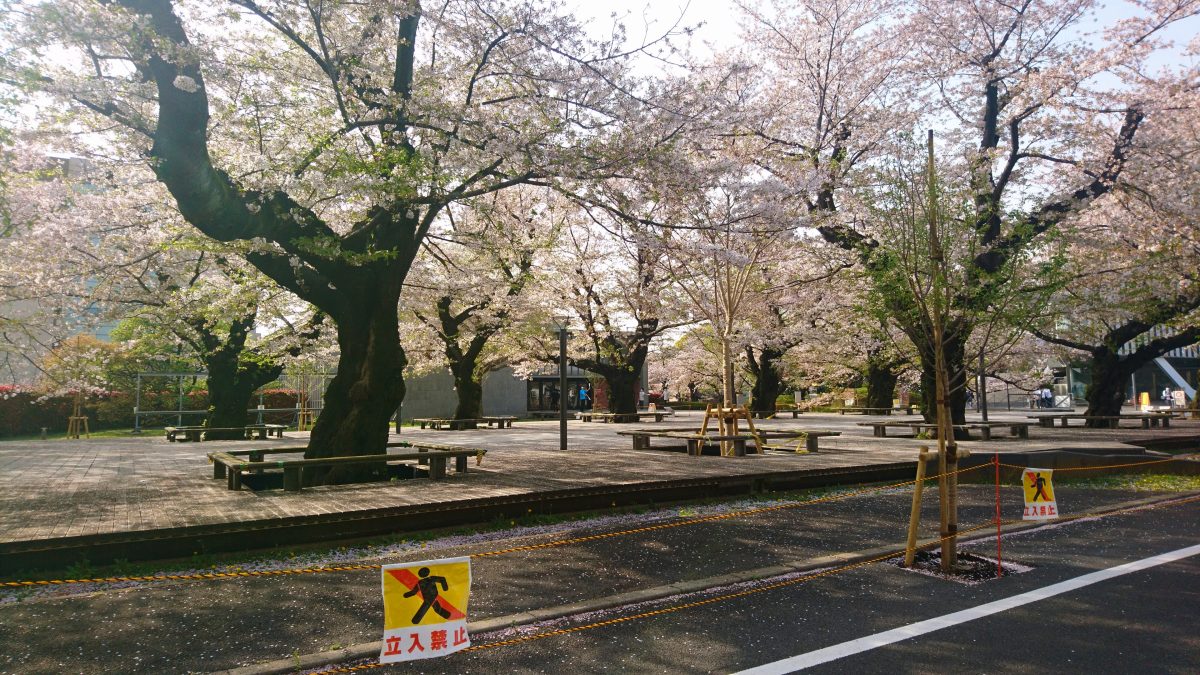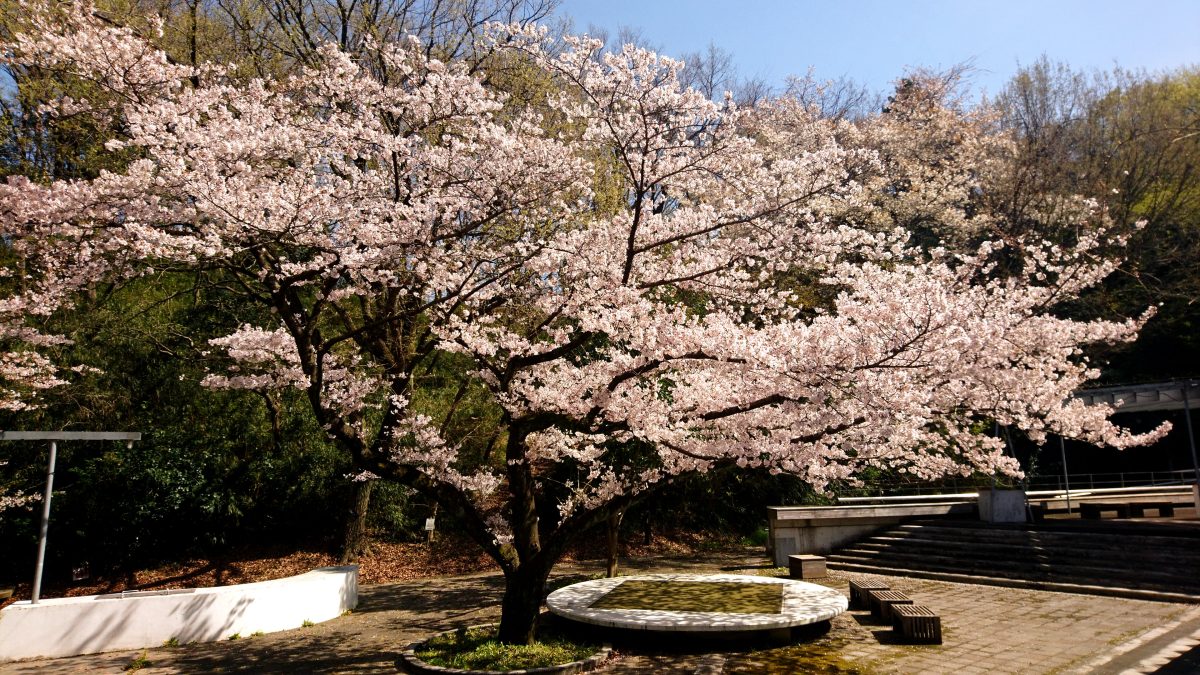[Featured image: Signs prohibiting entry to the cherry blossom platform, banning hanami picnics during the state of emergency in Tokyo]
Διαβάστε στα Ελληνικά εδώ
Το ήσυχο χανάμι του 2021
Η αρχή της άνοιξης συμπίπτει με την περίοδο του χανάμι στην Ιαπωνία. Παρόλο που συχνά μεταφράζεται ως ‘θέαση των ανθισμένων κερασιών’, η λέξη 花見 (=χανάμι) σημαίνει κυριολεκτικά το “να βλέπεις (見) τα λουλούδια (花)”. Ωστόσο, πλέον ο όρος αναφέρεται…
Early spring is known as hanami season in Japan. Although translated as ‘cherry blossom viewing’ in English, the word 花見 (=hanami) literally means “to watch (見) the flowers (花)”. However, by now the term refers almost exclusively to cherry blossoms. A colorful extravaganza, the first trees to blossom are usually plum and peach trees, ume (梅) and momo (桃), respectively. Although plums grabbed the attention of royals and royal gardeners in Heian period, the Samurai of the later Edo period appreciated the ephemeral nature of cherry blossoms, the sakura (桜). If I had to choose between them, I would choose the plums, but with a BUT. A single blossoming Hanamomo (flowering peach), might be enough to attract attention, but in no way can compete with the pale pink of a grove of cherry trees. The blossoming of cherries is shorter, the colors calmer, which prompts one to think about the short-term of life and the meaning of death.
Similarly to theatrical plays, the hanami season has a start, a peak and an end. Sometime in early spring, one or two trees start quietly blossoming, while the branches of the majority of trees remain naked. At some point, most trees wake up simultaneously and start blossoming at once, resulting in a thick layer of blossoms. As the spring rains start, the wind and the rain tear the petals down, throwing them into rivers and pavements, where they form a pink moving sheet. The petals flowing along the river are called poetically hanaikada (花筏), because they look like tiny rafts made of flowers.
Cherry blossoms are a common feature in school graduations, as the school year in Japan ends in late March and the new year starts in early April. University campuses sometimes have a section with a bunch of sakura trees to facilitate graduation photographs. After all, the blossoms match the kimono and hakama worn for the occasion. The blossoming of cherries lasts approximately 2 weeks, so the Japan Meteorological Agency prepares an annual forecast of the expected cherry blossoming time for each area. In tropical Okinawa the trees bloom a bit early, in February, while in northern Akita it might take until May. For some reason, nature decided that mid-March was a good time for cherry trees to blossom in 2021, ignoring the social events that expect April to be the official hanami season. I explained the differences between ume and sakura in a previous post, but the one thing to keep in mind is that sakura hanami is basically a synonym for drinking parties under the trees (although some folks that lack patience start drinking from when ume start blooming). As the saying goes, ‘Hana yori dango’ (花より団子), which means that the sweet dumplings, food and drinks are more important than the flowers themselves. This year, the same as last year, hanami parties were discouraged, as Tokyo was getting through its second state of emergency.
Because cherry trees serve as a reminder of our lives, they are planted everywhere, especially close to temples and rivers. Most trees are of the Shomei Yoshino variety, a flowering hybrid of the common cherry tree. One would think that with so many sakura trees, there would be an abundance of cherries. On the contrary, the most lavishly blossoming varieties fail to produce fruit. All the effort of the plant is spent on creating magnificent flowers, so there is none left for a cherry fruit. Although sakura are worthless are trees, great care is taken into planting them in as many places as possible in order to enjoy -a week at most- of full bloom. Moreover, there are other hybrids that make the viewing season longer, e.g. the early-blossoming Kawazu-zakura (河津桜) from Izu peninsula. Another variety is the Genpei (源平), with white- and vivid pink-colored petals fighting on the same blossom, commemorating the war between the Genji (源氏, alternatively Minamoto) and the Heike (平家, alternatively Taira) clans in the 12th century. Maybe you have heard the legendary battle of Dan-no-Ura, or the story of the blind Biwa musician, as told in Kwaidan by Lafcadio Hearn, referring to that decades-long war. A more voluptuous variety is Yae-zakura (八重桜), featuring double or even triple layers of petals, making the flower look more like a rose. The area around Mt. Fuji is famous for the short, fuchsia Shibazakura (芝桜) bushes and the feral Mame-zakura (豆桜). Some trees with branches stretching downward towards the ground, reminiscing weeping willows, are referred to as Shidare-zakura (しだれ桜).
In order to enhance the color of the trees, a lot of them are planted together in a row, usually next to a river or around a lake. The practice of planting multiple cherry trees started early, in the Tokugawa shogunate era, and continues vigorously until now. A lot of times the sakura trees are numbered with tags and examined regularly for their health condition. As I said, they don’t produce fruit, but their petals are used in macha latte and the leaf is pickled to serve as a wrap for sakura-mochi cakes.
There are a couple of must spots for cherry blossom viewing in Tokyo. These are: Chidori-ga-Fuchi next to the imperial palace, the imperial garden Shinjuku Gioen and the banks of Meguro river. All of them get insanely crowded under normal circumstances, and it is difficult to walk with your own pace among the crowds. In the past few years, I have learned to stay away of crowds and look for hidden locations, that only the locals know about. Turns out that the small canal next to my new house is lined with sakura cherry trees for more than 2 kilometers, making it perfect for long walks under the blossoms. It also has many varieties that bloom at different times, so the hanami season lasted a month and a half. At some point, the banks of the canal are paved, with stone tables and chairs, a perfect spot for night picnics, that neighbors make a good use of.
The one must spot that I visit every year is Meguro, mostly because it was the first even hanami I went to. In good times, companies and associations donate pink lanterns to be hanged next to the river in between the branches. The contrast between the vivid fuchsia of the lanterns and the pale pink of sakura blossoms makes them appear even more pinkish. Stalls with street food are set up at every corner and the drink of the day is a plastic glass of champagne with a strawberry inside. This year, the lanterns and stalls were missing, but somehow there were people taking selfies with glasses of strawberry champagne.
More than rivers, I think I prefer parks during hanami. There are enough trees to secure a picnic spot under, and enough space to play around. My favorite recently is the large Kinuta park in Setagaya. This year it was much emptier than normal, usually every patch of grass is covered with a picnic mat. Still, it was nice to chill on a sunny day, watching the cherry and peach trees.
Finally, we reached the end of today’s explanation of the famous hanami. Here are a couple more pictures of sakura, because I could not choose between them. And after the sakura, I’ve added some other random flowers, just because all flowers fit in the hana- part of the hanami, all of them are pretty to see. The next batch of flowers to blossom in the coming months are wisterias (called fuji 藤, different kanji than that of the mountain), azaleas (tsutsuji 榴) and hydrangeas (ajisai 紫陽花). Some popular spots for these flowers are at Kameido Tenjin shrine in Oshiage, in a park in Maebashi city in Gunma prefecture and at Ikegami Honmonji tempe in Ota, respectively.
Enough with the sakura, here are the lesser (to some, not to me) flowers blooming now!
See you next time!
Read about past (and future) blossoming seasons
Apparently, cherry trees in Yokohama were tricked into blooming in October! 🌸
Irregular cherry blossoms in autumn made big news back in Greece. My mom kept sending me articles about it, but I hadn’t witnessed anything like…
Kahlua Matcha and Sakura cherry coffee
As the hanami madness is just a month away, when everyone’s hobby becomes drunk-sleeping under sakura trees, covered by cherry blossoms dancing on the cool…
Το ήσυχο χανάμι του 2021
Η αρχή της άνοιξης συμπίπτει με την περίοδο του χανάμι στην Ιαπωνία. Παρόλο που συχνά μεταφράζεται ως ‘θέαση των ανθισμένων κερασιών’, η λέξη 花見 (=χανάμι)…






One thought on “The dampened cherry blossom season of 2021”